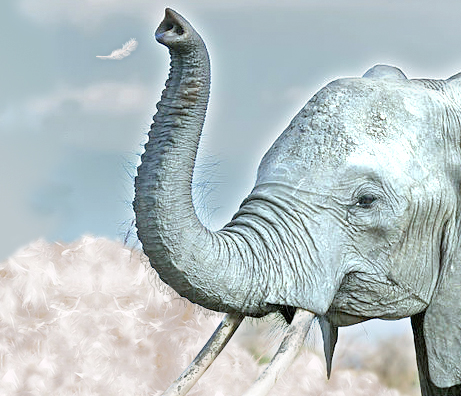 There is an old joke: what weighs more, ten tons of feathers
or a ten-ton elephant? The question is a tricky one! It is worded so we are
drawn to the two extreme subjects of the question: the light, fluffy feather
compared to an enormous elephant. If you think about only about the subjects,
you might find yourself answering that the elephant is obviously heavier. But
the answer lies not with the subjects, but with the qualifiers: the ten tons. The
real answer is that neither ten tons of feathers nor the ten-ton elephant
weighs more than the other: they are equal (10 tons of anything = 10 tons of
something else). This is the correct answer unless you are talking about
marketing.
There is an old joke: what weighs more, ten tons of feathers
or a ten-ton elephant? The question is a tricky one! It is worded so we are
drawn to the two extreme subjects of the question: the light, fluffy feather
compared to an enormous elephant. If you think about only about the subjects,
you might find yourself answering that the elephant is obviously heavier. But
the answer lies not with the subjects, but with the qualifiers: the ten tons. The
real answer is that neither ten tons of feathers nor the ten-ton elephant
weighs more than the other: they are equal (10 tons of anything = 10 tons of
something else). This is the correct answer unless you are talking about
marketing.
You see, there is marketing that is meaty and carries a lot
of weight. It gets the word out about your brand. It helps customers identify
with you. It is the ten-ton elephant in the room… you cannot miss it. Then
there is lightweight marketing fluff. It kind of promotes your brand, but on a
softer side, so no one really notices it. It never really convinces anyone to engage
with your brand outside of collecting a few likes on social media. The world is
full of ten tons of marketing feathers right now.
So what makes one piece of marketing an elephant and another
a big pile of feathers? Let’s start with the goal you are trying to achieve
with your brand marketing. You should have one general goal with your
marketing: to promote your products and services so you increase sales. But before
you can get to the sale, you will need to promote your brand. People need to
know what your brand stands for before they will consider making a purchase. A
typical goal for brand awareness marketing is to reach a level of cognizance
with your target market whereby they know your brand by name and associate with
your product. The ultimate in brand awareness is when a potential customer
begins to refer to your product by its brand name rather than its function
(think about calling a facial tissue a Kleenex or a tablet computer an iPad.)
Within that brand awareness is also the position your
product or service has in its marketplace. Weighty marketing makes a marketing
positioning statement with their brand awareness marketing. It tells you boldly
where its edge is in the marketplace. For instance, let’s take two retail store
brands: Target and Crate & Barrel. Target is a discount retailer, a place
you would go to get a low price on a great number of products. Crate & Barrel
is a trendy housewares and furniture retailer. Target sells furniture and home
accessories, but they also sell clothing, groceries, toys, etc. Crate &
Barrel specializes and Target generalizes. All of that is part of their brand
positioning. If I were to purchase a chair from Crate & Barrel, I would
expect it would be more expensive than a chair purchased at Target. If I wanted
to buy socks, I would not consider Crate & Barrel, but I would think about
Target. It is all summed up in the brand’s positioning.
Are
you peddling your brand with feathers or with elephants? No one gets to meaty
brand marketing by accident. You have to plan to be bold, but you also have to
plan to be on target. Make sure your marketing strategies are both leaving your
customers with the unmistakable impression of your brand and positioning it in
the way you want them to remember you. Brand awareness is the first step
towards a sale.
__________________
Elephant photo by Muhammad Mahdi Karim